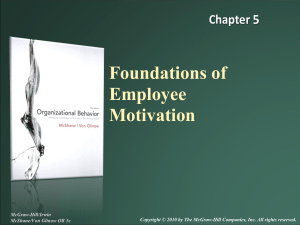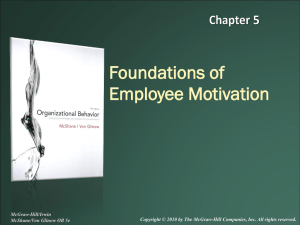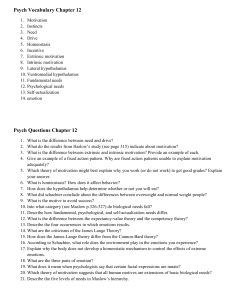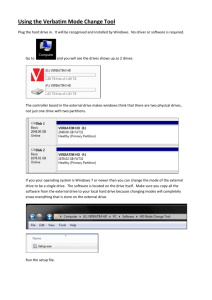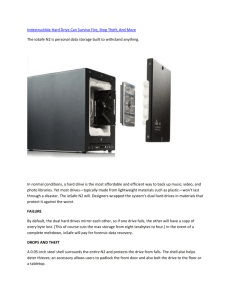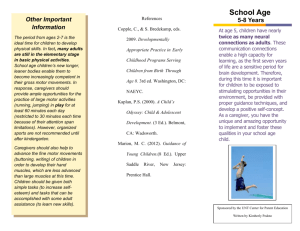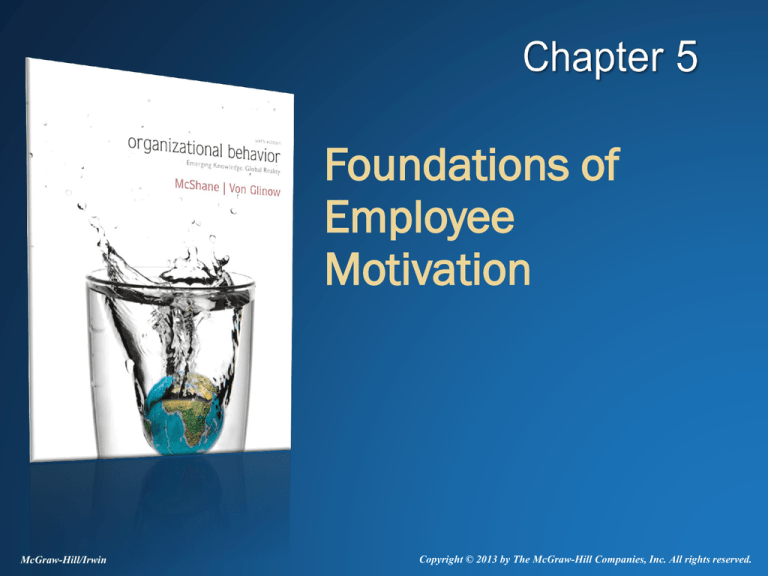
Foundations of
Employee
Motivation
McGraw-Hill/Irwin
Copyright © 2013 by The McGraw-Hill Companies, Inc. All rights reserved.
Standard Chartered Bank
Standard Chartered Bank
has improved employee
engagement and motivation
through goal setting,
strengths-based feedback,
employee development, and
other practices.
5-2
Motivation Defined
The forces within a person
that affect the direction,
intensity, and persistence
of voluntary behavior.
Exerting particular effort
level (intensity), for a
certain amount of time
(persistence), toward a
particular goal (direction).
5-3
Employee Engagement
Individual’s emotional and
cognitive (rational)
motivation, particularly a
focused, intense, persistent,
and purposive effort toward
work-related goals.
High absorption in the work.
High self-efficacy – believe
you have the ability, role
clarity, and resources to get
the job done
5-4
Drives and Needs
Drives (primary needs, fundamental needs, innate
motives)
• Hardwired brain characteristics (neural states) that energize
individuals to maintain balance by correcting deficiencies
• Prime movers of behavior by activating emotions
Self-concept, social norms,
and past experience
Drives
and Emotions
Needs
Decisions and
Behavior
5-5
Drives and Needs
Needs
• Goal-directed forces that people experience.
• Drive-generated emotions directed toward goals
• Goals formed by self-concept, social norms, and experience
Self-concept, social norms,
and past experience
Drives
and Emotions
Needs
Decisions and
Behavior
5-6
Maslow’s Needs Hierarchy Theory
Selfactualization
Need to
know
Seven categories – five in a
hierarchy -- capture most needs
Need for
beauty
Lowest unmet need is
strongest. When satisfied, next
higher need becomes primary
motivator
Self-actualization -- a growth
need because people desire
more rather than less of it when
satisfied
Esteem
Belongingness
Safety
Physiological
5-7
What’s Wrong with Needs Hierarchy
Models?
Maslow’s theory lacks empirical
support
• People have different hierarchies
• Needs change more rapidly than
Maslow stated
Hierarchy models wrongly
assume that everyone has the
same (universal) needs hierarchy
Instead, needs hierarchies are
shaped by person’s own values
and self-concept
Abraham Maslow
5-8
What Maslow Contributed to
Motivation Theory
Holistic perspective
• Integrative view of needs
Humanistic perspective
• Influence of social dynamics, not
just instinct
Positive perspective
• Pay attention to strengths
(growth needs), not just
deficiencies
Abraham Maslow
5-9
Learned Needs Theory
Needs are amplified or suppressed through
self-concept, social norms, and past
experience
Therefore, needs can be “learned”
• strengthened through reinforcement, learning, and
social conditions
5-10
Three Learned Needs
Need for achievement
• Need to reach goals, take responsibility
• Want reasonably challenging goals
Need for affiliation
• Desire to seek approval, conform to others wishes,
avoid conflict
• Effective executives have lower need for social approval
Need for power
• Desire to control one’s environment
• Personalized versus socialized power
5-11
Four-Drive Theory
Drive to Acquire
• Drive to take/keep objects and
experiences
• Basis of hierarchy and status
Drive to Bond
• Drive to form relationships and
social commitments
• Basis of social identity
Drive to Learn
• Drive to satisfy curiosity and
resolve conflicting information
Drive to Defend
• Need to protect ourselves
• Reactive (not proactive) drive
• Basis of fight or flight
5-12
How Four Drives Affect Motivation
1.
Four drives determine which emotions are
automatically tagged to incoming information
2.
Drives generate independent and often
competing emotions that demand our attention
3.
Mental skill set relies on social norms, personal
values, and experience to transform drivebased emotions into goal-directed choice and
effort
5-13
Four Drive Theory of Motivation
Drive to
Acquire
Drive to
Bond
Drive to
Learn
Social
norms
Personal
values
Past
experience
Mental skill set resolves
competing drive demands
Goal-directed
choice and effort
Drive to
Defend
Social norms, personal values, and
experience transform drive-based emotions
into goal-directed choice and effort
5-14
Implications of Four Drive Theory
Provide a balanced opportunity for employees
to fulfill all four drives
• employees continually seek fulfilment of drives
• avoid having conditions support one drive more
than others
5-15
Expectancy Theory of Motivation
E-to-P
Expectancy
P-to-O
Expectancy
Outcomes
& Valences
Outcome 1
+ or -
Effort
Performance
Outcome 2
+ or -
Outcome 3
+ or -
5-16
Increasing E-to-P and P-to-O
Expectancies
Increasing E-to-P Expectancies
• Develop employee competencies
• Match employee competencies to jobs
• Provide role clarity and sufficient resources
• Provide behavioral modeling
Increasing P-to-O Expectancies
• Measure performance accurately
• Increase rewards with desired outcomes
• Explain how rewards are linked to performance
5-17
Increasing Outcome Valences
Ensure that rewards are valued
Individualize rewards
Minimize countervalent outcomes
5-18
A-B-Cs of Behavior Modification
Antecedents
Behavior
Consequences
What happens
before behavior
What person
says or does
What happens
after behavior
Machine
operator turns
off power
Co-workers
thank
operator
Example
Warning
light
flashes
5-19
Four OB Mod Consequences
Positive reinforcement – any consequence that,
when introduced, increases/maintains the target
behavior.
Punishment – any consequence that decreases the
target behavior.
Negative reinforcement –any consequence that,
when removed, increases/maintains target behavior.
Extinction – when no consequence occurs, resulting
in less of the target behavior
5-20
Reinforcing the Healthy Walk
The British municipality of Stokeon-Trent, Staffordshire, issued
pedometers to its staff and
encouraged them to do more
walking each day. The
pedometers provide instant
feedback and positive
reinforcement to motivate longer
walks. Some organizations also
reinforce walking with financial
rewards.
5-21
Behavior Modification in Practice
Behavior modification
applications:
• every day to influence behavior of
others
• company programs – attendance,
safety, etc.
Behavior modification problems:
• Reward inflation
• Variable ratio schedule viewed as
gambling
• Ignores relevance of cognitive
processes in motivation and
learning
5-22
Social Cognitive Theory
Learning behavior outcomes
• Observing consequences that others experience
• Anticipate consequences in other situations
Behavior modeling
• Observing and modeling behavior of others
Self-regulation
• People engage in intentional, purposive action – they
develop goals, achievement standards, action plans
• People form expectancies (anticipate consequences)
from others -- not just from their own experiences
• People reinforce their own behavior (selfreinforcement)
5-23
Goal Setting
The process of motivating employees and
clarifying their role perceptions by establishing
performance objectives
5-24
Effective Goal Setting Characteristics
Specific – What, how, where, when, and with
whom the task needs to be accomplished
Measurable – how much, how well, at what cost
Achievable – challenging, yet accepted (E-to-P)
Relevant – within employee’s control
Time-framed – due date and when assessed
Exciting – employee commitment, not just
compliance
Reviewed – feedback and recognition on goal
progress and accomplishment
5-25
Balanced Scorecard
Organizational-level goal setting and
feedback
Attempts to include measurable performance
goals related to financial, customer, internal,
and learning/growth (i.e., human capital)
processes
Usually includes several goals within each
process
5-26
Characteristics of Effective Feedback
1.
2.
3.
4.
5.
Specific – connected to goal details
Relevant – Relates to person’s behavior
Timely – to improve link from behavior to
outcomes
Credible – trustworthy source
Sufficiently frequent
• Employee’s knowledge/experience
• Task cycle
5-27
Strengths-Based Coaching
Feedback
Maximizing the person’s
potential by focusing on their
strengths rather than
weaknesses
Motivational because:
• people inherently seek feedback
about their strengths, not their
flaws
• person’s interests, preferences,
and competencies stabilize over
time
5-28
Multisource Feedback
Received from a full circle of people around
the employee
Provides more complete and accurate
information
Several challenges
• expensive and time-consuming
• ambiguous and conflicting feedback
• inflated rather than accurate feedback
• stronger emotional reaction to multiple feedback
5-29
Organizational Justice
Distributive justice
• Perceived fairness in
outcomes we receive relative
to our contributions and the
outcomes and contributions
of others
Procedural justice
• Perceived fairness of the
procedures used to decide
the distribution of resources
5-30
Equity Theory
Your Own
Outcome/Input Ratio
Comparison Other’s
Outcome/Input Ratio
Own outcomes
Other’s outcomes
Own inputs
Compare
own ratio with
Other’s ratio
Other’s inputs
Perceptions of
equity or inequity
5-31
Elements of Equity Theory
Outcome/input ratio
• inputs -- what employee contributes (e.g., skill)
• outcomes -- what employee receives (e.g., pay)
Comparison other
• person/people against whom we compare our ratio
• not easily identifiable
Equity evaluation
• compare outcome/input ratio with the comparison
other
5-32
Correcting Inequity Tension
Actions to correct
underreward inequity
Example
Reduce our inputs
Less organizational citizenship
Increase our outcomes
Ask for pay increase
Increase other’s inputs
Ask coworker to work harder
Reduce other’s outputs
Ask boss to stop giving preferred treatment
to coworker
Change our perceptions
Start thinking that coworker’s perks aren’t
really so valuable
Change comparison other
Compare self to someone closer to your
situation
Leave the field
Quit job
5-33
Procedural Justice
Perceived fairness of procedures used to
decide the distribution of resources
Higher procedural fairness with:
• Voice
• Unbiased decision maker
• Decision based on all information
• Existing policies consistently
• Decision maker listened to all sides
• Those who complain are treated respectfully
• Those who complain are given full explanation
5-34
Foundations of
Employee
Motivation

